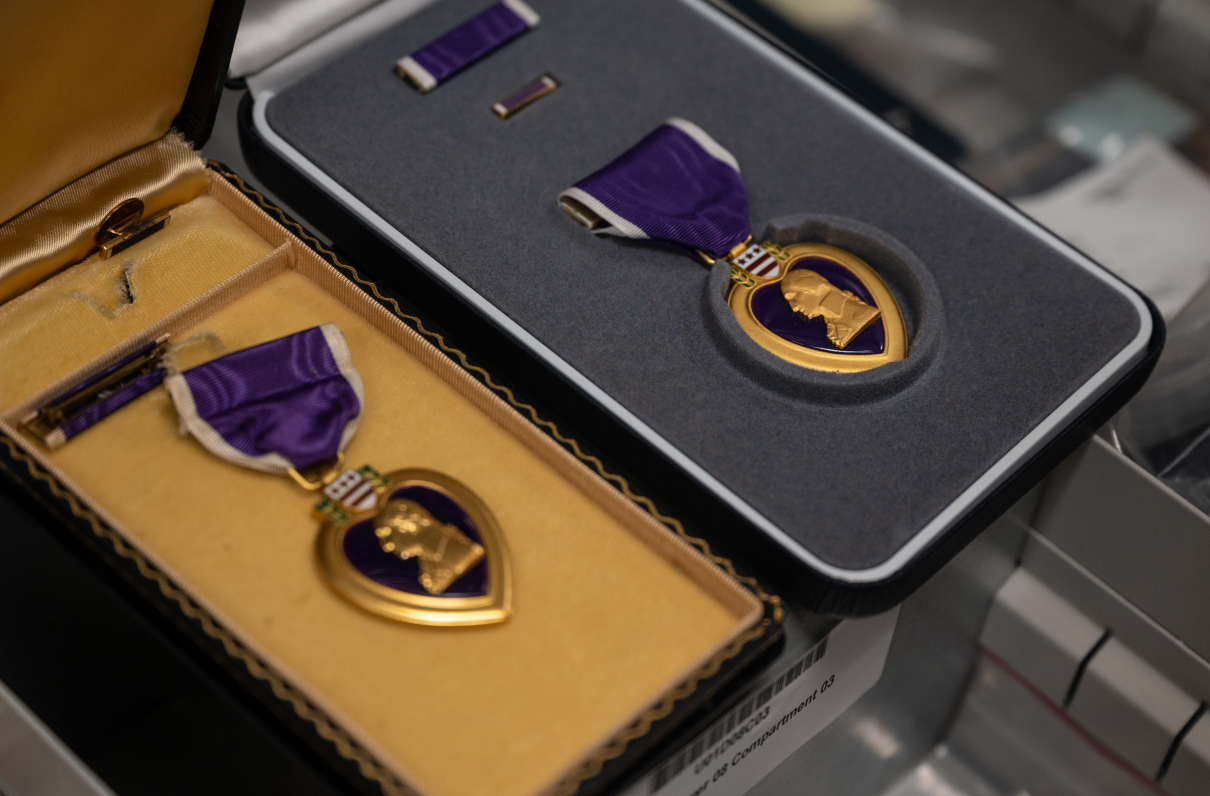Editor’s note: This article by Sarah Sicard originally appeared on Military.com, a leading source of news for the military and veteran community.
For decades, recipients of the Purple Heart were honored with medals that had been forged during World War II, leftover stock from preparations for the invasion of Japan that was expected to cost many American lives.
The Truman Library Institute estimated that 495,000 were left after the war, medals that would go on to be awarded to service members and families through the Korean War, Vietnam War, and on.
The Army’s Institute of Heraldry reported that sometime in the 1990s -- the Defense Logistics Agency, responsible for procuring the awards, said it didn't know exactly when -- officials realized that the once unimaginably large pile of medals had dwindled. DLA records are unclear on how the services honored troops in the intervening years, but in 2022, it turned to Steven Kennedy and his company, Kennedy Inc., to create new versions of the medals that meet specifications from the 1930s.
[RELATED: More Recommended Reads From MOAA]
The company had been making awards for service members for a couple of decades already, honoring sacrifices that were in Kennedy's blood.
His father, Capt. T. Frank Kennedy, landed on Omaha Beach on D-Day, while his uncle, Capt. John A. Kennedy, served as the head medical officer for the Rainbow Division. He was the first American doctor to enter Dachau, according to Kennedy. They survived World War II unscathed, but his other uncle, Navy pilot Lt. Jackson W. Findling, was killed in action over the South China Sea while returning to his aircraft carrier after a mission in 1961. Kennedy is uncertain whether his uncle received a posthumous Purple Heart, but believes he should have due to the nature of his passing.
All told, Kennedy said his company has made roughly 15,000 medals in the last three decades, continuing a tradition of honoring those who are wounded while serving. Today, it is the sole contractor left making the medals.
"I'm trying not to get a little emotional here," he told Military.com. "It means a lot to me personally."
[RELATED: Lou Conter, Last Survivor of USS Arizona From Pearl Harbor Attack, Dies at 102]
The awards, he noted, are made to the exact same specifications used in 1932 when Gen. Douglas MacArthur first titled the honor.
It consists of the brass-alloy medal featuring the profile of Washington, the purple insert that lies atop it, and the purple and white striped ribbon. The color represents bravery. On the back, it reads "For Military Merit."
The Purple Heart's history goes all the back to when George Washington served as first commander in chief in 1782. Previously called the "Badge of Military Merit," it was designated as a means of boosting morale among troops of all ranks. Washington would award that honor to three sergeants, according to the National WWII Museum.
However, beyond those three soldiers, the award was forgotten until World War I, and it wasn't tied to wounds until MacArthur renewed interest in it. He wrote in General Order No. 3 on February 22, 1932, about his desire for the medal's specifications to be updated from Washington's original intent.
"In an attached line, additional criterion for the Purple Heart included, 'A wound, which necessitates treatment by a medical officer, and which is received in action with an enemy of the United States, or as a result of an act of such enemy, may … be construed as resulting from a singularly meritorious act of essential service,'" National WWII Museum records indicate.
[FROM 2020: How to Track Down Your Military Records]
Charles Mugno, director of the Institute of Army Heraldry, said that World War II changed the awards system drastically.
"There were a few awards in around the early part of the 1940s, especially in Pearl Harbor, where the Purple Heart medal was given out for performance and not for a wound or death," he told Military.com. "But that was quickly changed after World War II expanded, and more medals were created to recognize performance. Then, the Purple Heart medal became a medal for recognizing those killed or wounded in combat."
An estimated 1.5 million Purple Hearts were produced during World War II, including the excess meant for casualties during the invasion of Japan that never happened.
Tradition remains a huge part of Purple Heart lore, which is why, when putting out the contract for a manufacturer, the Defense Department needed a company that could meet the same standards of the medals produced during World War II.
"Only in extraordinarily rare situations would there be any insignia change," Mugno added. "It's a legacy issue. So no matter when a soldier joins a unit, that badge patch … will be the common denominator of all soldiers past, present and future when it comes to military decorations."
Since 1932, it's estimated that 1.8 million Purple Heart medals have been awarded.
Though not everyone on his team has the same personal connection to the medals, Kennedy said, "We all share the same common goal, which is to make the best possible product we can each and every day here."
Wings of World War II
Get an in-depth, interactive look at some of the most significant U.S. aircraft in the war's "arsenal of democracy."
